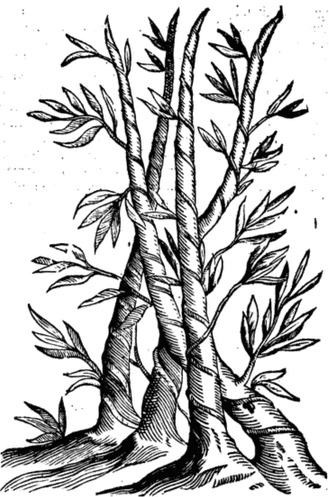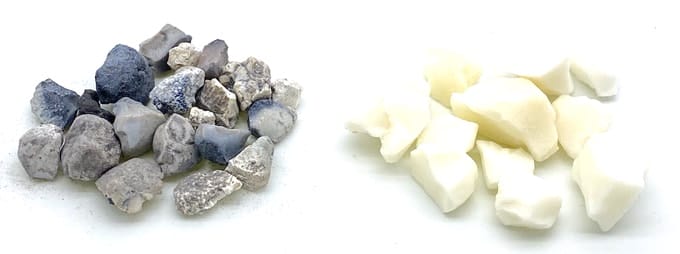Tabasheer, Tian Zhu Huang 天竺黄Bamboo Silica, Bamboo Manna, Bamboo Salt, Bamboo CamphorTian Zhu Huang (TCM) Vasalocana (Ayurveda) Cu Gan (Tibetan) Tabaashir (Unani) Bansalochan (Persian) Qasab (Arabic) |

|
 Indiae Utriusque re Naturali et Medica, Pisonis, 1658
Indiae Utriusque re Naturali et Medica, Pisonis, 1658Plantarum indigenarum et exoticarum Icones ad vivum coloratae, vol. 5 (1792)
 Two varieties of Tabasheer available on the market, Blue and White.
Two varieties of Tabasheer available on the market, Blue and White.(Adam, 2022)
 Members CLICK HERE for the PRO VERSION
Members CLICK HERE for the PRO VERSIONBotanical name:
Several species of Bamboo supply Tabasheer:
- Bambusa arundinacea (syn. B. bambos, Arundo bambos)
- Bambusa apous, B. orientalis, B. spinosa and others in Ayurveda;
- Phyllostachys nigra, P. reticulata and others sources in TCM.
Parts used:
Siliceous deposit from the nodes of certain Bamboo species.
Temperature & Taste:
Cold, Dry, Sweet, Astringent
Classifications:
2N. REPELLENTS. 2P. HEMOSTATIC. 2S. STRENGTHENING
3B. FEBRIFUGE & ANTIPYRETIC. 3D. CORDIALS & CARDIACS. 3K. EXPECTORANT. 3L. ANTI-TUSSIVE
4a. CEPHALIC. 4c. CARDIAC. 4d. PECTORAL. 4g. HEPATIC. 4j. NERVINE
TCM:
P. Clears Hot Phlegm
Constituents:
A. Natural Product:
-Silicic acid (up to 96%; Silicon dioxide (88%), Potassium (1.1%), Fe2O3 (0.9–4%), Aluminium oxide (3.5%), Calcium oxide
-Polysaccharides
-Amino acids
-Acetylcholine is found in Bamboo; it is not certain if it occurs in traces in natural Tabasheer
B. Synthetic Product:
-Silicon dioxide (92.5%), Fe2O3 (1.5%), Aluminium oxide (2%), Potassium, Calcium oxide
Uses:
1. Clears Heat and Toxin (TCM, West, Ayurveda, Tibetan):
-various types of Fever; Acute, Chronic, Stubborn and High Fevers
-Skin disorders including Eczema and Psoriasis
2. Clears Heat and Phlegm, Stops Cough, Benefits the Lungs (TCM, West, Ayurveda, Tibetan):
-acute and chronic Cough, Bronchitis, Asthma, and Wheezing
-acute Colds and Flu with Heat symptoms.
3. Clears Heat, Calms Wind, Stops Spasms (TCM, Ayurveda, Tibetan):
-Febrile Convulsions and Night Terrors in young children
–Paralysis, Parkinsonism, Pain over the whole body and in various Wind formulas (Tibetan Medicine)
-Headache and Migraine
4. Benefits the Heart, Clears Heart Fire: (TCM, West, Ayurveda, Tibetan):
-Palpitations with Anxiety from Heat, Fainting and Loss of consciousness; it has a soothing effect on the nerves.
-Melancholy, Depression and Grief. (Avicenna)
-“It is useful in hot Palpitation” (Avicenna)
-“Tabasheer strengthens the Heart” (Avicenna)
5. Clears Stomach Heat: (West, Ayurveda):
-‘vomiting, burning and weakness of the Stomach’. (Avicenna)
-‘Stops infiltration of yellow bile towards stomach and relieves pain’. (Avicenna)
6. Rasayana (Ayurveda, Tibetan, West):
-enhances the 7 Tissues and increases Sperm.
-Debility, Emaciation, Consumption; also Thirst. (see Restorative Electuary)
-regarded as strengthening, rejuvenating medicine, good for the elderly, and in convalescence.
7. Clears Heat, Stops Bleeding (Unani, Ayurveda, Tibetan):
-various types of bleeding from Heat or Fever
8. Kills Worms:
-Thread-worms in children. (Ayurveda)
9. Externally:
-Eye disorders (as a filtered wash)
-hot inflammations of the eye. (Avicenna)
-Mouth Ulcers. (Avicenna, TCM)
Dose:
… available in PRO version
Substitutes:
… available in PRO version
Correctives:
… available in PRO version

Main Combinations:
Six Excellent Medicines (Tibetan Medicine)
Heat & Fever
1. Fever:
i. Tabasheer with … available in PRO version
ii. Fever in Children, Tabasheer with … available in PRO version
iii. all types of Fever including Malaria and Meningitis: Tabasheer with … available in PRO version
iv. Burning Fever, … available in PRO version
v. Burning Fever, Tabasheer … available in PRO version
vi. Fever, Fever with Diarrhea, Hectic Fever, Consumption, Tabasheer with … available in PRO version
vii. High Fever with loss of consciousness, delirium, Tabasheer, … available in PRO version
2. Infantile Febrile Convulsions (see below for other types of Infantile Convulsions):
i. from Wind-Heat, Tabasheer, … available in PRO version
ii. from Heat-Phlegm, Tabasheer, … available in PRO version
iii. Tabasheer with … available in PRO version
3. Intolerable Thirst, Tabasheer with … available in PRO version
4. Liver heat:
i. Tabasheer with … available in PRO version
ii. Fever; Heat of the Liver, Bladder, Breast, Stomach, Tabasheer, … available in PRO version
5. Stop Bleeding, clear Heat and Inflammations, Tabasheer with … available in PRO version
Lungs
6. Cough:
i. Cough, Bronchitis, Chronic Lung diseases, Thirst, Tabasheer with … available in PRO version
ii. Cough and Cold, Tabasheer with … available in PRO version
iii. deficient Cough, Tabasheer with … available in PRO version
iv. Phlegm-Heat cough, Tabasheer with … available in PRO version
7. To clear Phlegm:
i. Tabasheer with … available in PRO version
ii. Tabasheer with … available in PRO version
8. Sore Throat, Hoarseness, Cough, Chest pain Tabasheer with … available in PRO version
9. Tuberculosis, Hectic Fever, Consumption, Tabasheer with … available in PRO version
10. Hemoptysis, Tabasheer with … available in PRO version
11. Lung Abscess, Tabasheer … available in PRO version
Digestive system
12. Loss of Appetite, Tabasheer with … available in PRO version
13. Stomach weakness, Vertigo, Dizziness, Tabasheer with … available in PRO version
Nervous System, Mental Illness, Wind diseases
14. Stroke with excess Phlegm, Tabasheer with … available in PRO version
15. Coma from Wind-Phlegm, Tabasheer with … available in PRO version
16. Wind-Phlegm-Heat obstructing the orifices of the Brain with Fever, Tabasheer with … available in PRO version
17. Heart Fire causing Madness, Mania, Hallucinations, Tabasheer with … available in PRO version
18. Schizophrenia, Tabasheer, … available in PRO version
19. Depressive Psychosis or Epilepy from Phlegm-Heat:
i. Tabasheer with … available in PRO version
ii. Tabasheer with … available in PRO version
iii. with intense heat (Fire), Tabasheer, … available in PRO version
20. Childhood Convulsions:
i. from Phlegm and Food, Tabasheer with … available in PRO version
ii. Tabasheer with … available in PRO version
iii. from Wind-Phlegm, Tabasheer with … available in PRO version
Other:
21. Diabetes:
i. Tabasheer with … available in PRO version
ii. Tabasheer, … available in PRO version
22. Threatened Miscarriage from Heat, Tabasheer with … available in PRO version
23. Leukorrhea, Tabasheer with … available in PRO version
24. Mouth Ulcers, Tabasheer, … available in PRO version
Major Formulas:
Troches of Spodium (Trochisci Spodii) (Nicholas)
Troches of Spodium (Trochisci Spodii) (Avicenna)
Cooling Electuary of Musk (Rhazes)
Powder for Hoarseness of the Throat
Red Hungarian Powder
Powder for Migraine (Alexander)
Noble Confection for the Heart
Restorative of Nicholas (Pleres Arconticon) (Nicholas)
Powder of Digher (Unani)
Powder of Muhafiz Janeen (Unani)
Bo Ying Compound
Sitopaladi Powder (Ayurveda)
Tabasheer 9
Six Excellent Medicines (Tibetan Medicine)
Powder for Childrens Fever (Tibetan Medicine)
Camphor 14 (Tibetan Medicine)
Clove 6 (Li shi drug pa) (Tibetan Medicine)
Raisin 7 (Tibetan Medicine)
Bi Ma La (Tibetan Medicine)
Principle 8 (Gtso bo brgyad pa) (Tibetan Medicine)
Principle 25 (Gtso bo nyer lnga) (Tibetan Medicine)
Eleven Holders of Life (Srog dzin dcu gcig) (Tibetan Medicine)
Gentiana algida 15 (Spang rgyan dkar po 15) (Tibetan Medicine)
Balancing Comforter (Bde byed snyoms) (Tibetan Medicine)
Aloeswood 8 (Tibetan Medicine)
Aloeswood 15 (Tibetan Medicine)
Aloeswood 31 (Tibetan Medicine)
Aloeswood 35 (Tibetan Medicine)
Amomum 19 (Ko la 19) (Tibetan Medicine)
Pearl 25 (Mu tig nyer lnga) (Tibetan Medicine)
Wish-fulfilling Jewel (Bsam phel nor bu) (Tibetan Medicine)
Bao Long Wan (Dragon-sedating Pill)
Tablet of Tabasheer (Qurs Tabasheer) (Unani)
Cautions:
1. Not used in marked Coldness or Yang deficiency.
2. It is corrected and enhanced when combined with pungent medicines like Ginger or Pepper.
3. Avoid inhaling the powder as it is almost pure silica.
Main Preparations used:
Troches of Spodium
|
‘The Bamboo, in Sanskrit Vansa and Venu, is considered by the Hindus to have the hardest of woods. The word also signifies ‘spine’ and ‘lineage,’ thus Vansa-visuddha means “made of a good bamboo,” i.e. ,of a pure or good family, and Vansa-dhara ” carrying a bamboo,” i.e., maintaining a family, Vansa-pratishthana-kara “establishing a family on a sure foundation.” The Abbe Dubois, in his Description of India, states that the young Indian bride and bridegroom are made to stand in two bamboo baskets placed side by side, and the Kul or Arbor generations of the caste, at Hindu marriages, is placed in a winnowing fan made of bamboo. The wild tribes of the Garrow hills, who have no temples or altars, set up opposite their huts a bamboo post which they deck with flowers and tufts of cotton, and before it they make offerings to their god. Indian anchorites carry a bamboo stick having seven knots. A bamboo flowering is an event of rare occurrence, and which is supposed to bring in its train all sorts of evil, accompanied by dire distress and famine. The seeds of the bamboo, in Sanskrit Vansa-tandula, Vansa-ja, Venu-yava, Venu-vija, have often proved of great value in famine seasons, saving thousands of lives ;this was the case in Orissa in 1812 and in Canara in 1864. The young shoots which appear towards the end of the rainy season are used as a vegetable ; they are minced very finely and soaked in water to remove the bitter taste, and then cooked with dal, and seasoned according to taste : they are also made into pickle. A decoction of the joints of the bamboo is supposed to have an action on the uterus, and is used by females after delivery to cause a free flow of the lochial discharge. The same part of the plant pounded with water is applied to inflamed joints. The juice of the leaves with aromatics is given in haematemesis. The leaves are very commonly given to horses by syces as a remedy for coughs and colds. Bamboo manna is the Vansa-lochana of the Indian physicians; in the Nirghantas it bears many synonyms, such as Vansa-rochana, Tvak-kshiru “bark-milk,” Vansa-karpura “bamboo camphor,” Vansa-sarkara” bamboo sugar,” Vansuhva “bamboo sacrifice,” Subhra, and Sita “white,” &c. It is considered to be strengthening, tonic, cold, and sweet; to alleviate thirst, and to avert phthisis, fever, asthma, cough, biliousness, skin diseases, and Vayu (morbid affections of the windy humor). As an example of the way in which it is prescribed, the following formula for making the Sitopaladi-churna will be found in Sarangadhara:— Bamboo manna 8 parts, long pepper 4, cardamoms 2, cinnamon 1, sugar 16. Powder and mix. Dose about 60 grains, to be given with honey and ghee in phthisis and cachexia. The belief in the strengthening properties of bamboo manna appears to have originated among the aboriginal tribes of India, as on the West Coast it is the first solid food which the Thana Kolis give their children. The same belief seems to have prevailed in Borneo, as Marco Polo relates that pieces of this substance were let in under the skin by the natives to make the body wound-proof. We hold with Salmasins that bamboo manna was the substance known to the Greeks as [?], and described |
by them as a white, concreted or crystalline substance like common salt, because there was no kind of sugar prepared from the sugar-cane, answering to this description, known in India in the time of Dioscorides. The name Sarkara, which signifies “grit, pebbles, sand,” was applied by Hindu writers at that time to several substances, viz., Guda or molasses in a dry granular state, the only kind of cane-sugar then in use in India; Yavasa-sarkara, the concrete manna of Alhagi; and Vansa sarkara, the concretion found in the bamboo. The Sanskrit name Khanda was also applied to Guda, which is the substance known in the vernaculars as Gur or Gul, and is still the kind of sugar most used by the Hindus. Pale crystalline sugar, the Chini of the bazars, does not appear to have been known until some 400 years after the date of Dioscorides. Under the name of Tabashir, a corruption of the Sanskrit Tvak-kshira, bamboo manna was known to the early Arab travellers in the East; the port of Thana, on the West Coast of India, was famous for its Tabashir in the time of Idrisi (1135) and supplied it to all marts. Ibn Sina describes Tabashir as astringent and stomachic, useful in erysipelas and to allay thirst in bilious-dyspepsia, cardiacal, and strengthening. Asa local application it is used to relieve the heat and irritation caused by aphthous eruptions along with pounded rose leaves. Later Mahomedan writers upon the Materia Medica of the East have added nothing of importance to Ibn Sina’s account of the drug. Fliickiger (Zur Geschichte des Tabazchir, Zeit. des allg. oster: Apoth. Ver. Nr. 14 u. 15, 1887) mentions a list of Indian goods on which transit duty was levied at Aden in 1270; in it Tabashir is mentioned together with tamarinds and camphor. He also draws attention to a remarkable connection between Tabashir and ivory ashes, generally known by the name of Spodium. Idrisi, in the middle of the 12th century, points out that the latter was used to adulterate the former, while others of a different opinion assign a greater value to Spodium. Garcia d’Orta (Colloquios 5 1) mentions both Tabashir and Spodium, which he considers to be Pompholyx or Turtia (white of zinc ? calamine ?), and states that in Persia and Arabia Tabashir was generally paid for by its weight in silver (“o preso ordinario na Persia e Arabia 6 a peso de prata “); he also describes black or grey Tabashir, which was of less value and was obtained by burning the bamboo cane. Fliickiger remarks that it is most likely that the name “Spodium da canna ” was given to this black Tabashir or perhaps to the ashes of the cane, and that it might be owing to this circumstance that in later times the name Spodium came to be applied to animal charcoal (bone- black). The idea of black seems not to have been connected with the original Greek name [?] (ashes). Fliickiger also draws attention to the Latin translation of a Persian Karabddin or Pharmacopoeia by the Carmelite Friar P. Angelus, published in Paris in 1681, in which Tabashir is spoken of as pseudo-spodium, anti-spodium, and spodium-arabicum. Rheede as well as Rumphius notice Tabashir, but it does not appear to have attracted much attention in Europe until Dr. Patrick Russell drew the attention of the Royal Society to it, and induced James Louis Macie to make an analysis, which showed that it consisted principally of silica’. (Pharmacographia Indica, Dymock, 1893) |
2. An Account of Some Chemical Experiments on Tabasheer, James Louie Macie, Esq, Med Facts Obs, 1793
